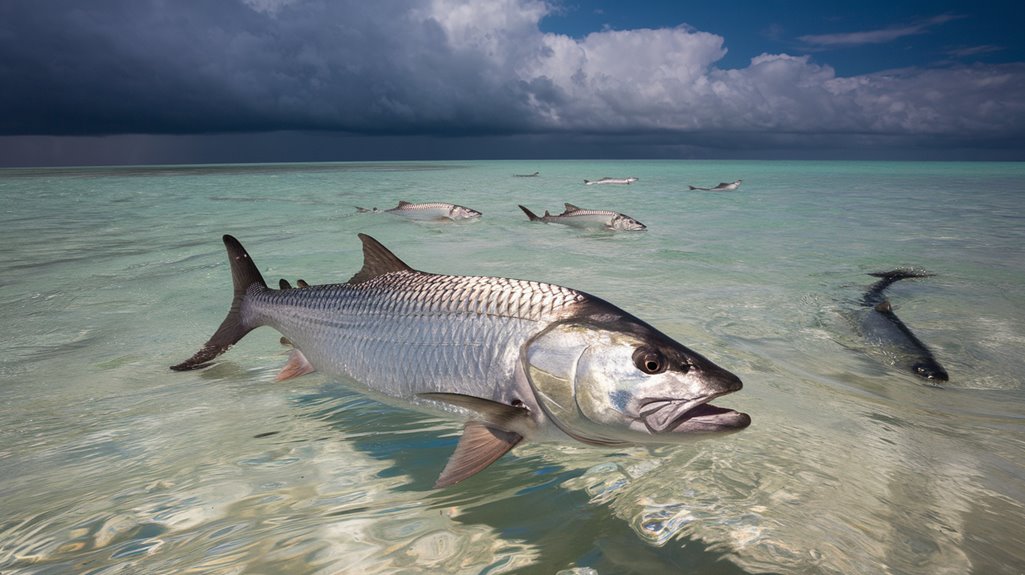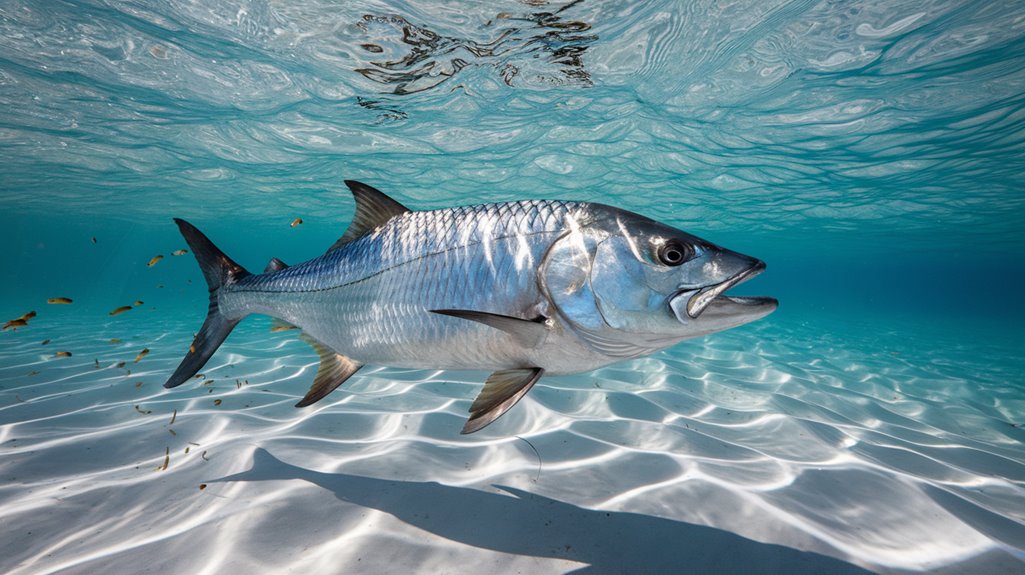You'll find that tarpon possess specialized guanine crystals in their retinas that enhance their ability to detect movement in varying water conditions. These ancient fish can process visual information four times faster than humans, allowing them to track prey with remarkable precision in clear water. Yet when conditions turn murky, they'll shift to rely heavily on their lateral line sensory system. Understanding how water clarity affects their behavior is essential for predicting where and when you'll find success on the water.
- Key Takeaways
- The Science Behind Water Clarity and Tarpon Vision
- Adapting Fishing Techniques for Different Water Conditions
- Seasonal Changes in Water Clarity and Their Effects
- Best Locations for Clear vs. Turbid Water Fishing
- Weather Patterns That Impact Water Visibility
- Enhancing Success Rates Through Water Quality Assessment
- Frequently Asked Questions
- Conclusion
Key Takeaways
- Clear water enables tarpon to track prey with high precision, while murky conditions force reliance on lateral line sensitivity.
- Tarpon become more active in shallow waters during overcast conditions due to improved visibility and hunting efficiency.
- Water clarity influences fly selection, with natural colors working best in clear water and bright patterns for murky conditions.
- Spring's increased water clarity triggers aggressive feeding behavior as tarpon move into shallower areas.
- Storm fronts and rainfall decrease water clarity, often triggering changes in tarpon feeding patterns and locations.
The Science Behind Water Clarity and Tarpon Vision
While many fish species adapt to varying water conditions, tarpon possess remarkably advanced vision that sets them apart as apex predators in both clear and turbid environments. Their exceptional visual capabilities allow them to maintain effective feeding activity across different levels of water clarity, particularly during low-light periods at dawn and dusk.
In clear water, you'll find tarpon actively pursuing prey species with heightened precision, as they can easily track subtle movements and changes in their surroundings. When confronted with murky waters, these fish don't solely rely on vision; they utilize their lateral line sensitivity to detect vibrations from potential prey. Understanding these adaptations is essential for selecting appropriate fishing techniques, as the effectiveness of fly patterns varies considerably between clear and turbid conditions.
Adapting Fishing Techniques for Different Water Conditions
When targeting tarpon in clear water, you'll need to prioritize stealth with unweighted flies and natural colors while maintaining a slow, erratic retrieve to mimic wounded prey. In murky conditions, you'll find more success using larger, brighter weighted flies that create more vibration and movement, which tarpon can detect through their lateral lines. Your retrieve speed should increase in turbid water, as aggressive presentations become more effective when tarpon exhibit bolder feeding behavior in low-visibility environments.
Clear Water Strategies
As water clarity fluctuates in tarpon habitats, anglers must adapt their techniques to match these changing conditions. In clear water, tarpon's heightened sensitivity demands stealthy approaches and minimal disturbance. Environmental factors like wind and wave activity directly influence visibility, affecting how these fish respond to your presentation.
- Use unweighted flies that mimic wounded prey, allowing for natural, erratic movements without surface disturbance
- Select flies with subtle, natural colors that match local forage species
- Time your fishing during low-light conditions at dawn or dusk when tarpon are less cautious
- Monitor wind patterns and wave activity to anticipate changes in water clarity
Understanding these clear water strategies helps you adapt your presentation methods while maintaining stealth. Success depends on reading water conditions and adjusting your approach accordingly, particularly when targeting these sight-sensitive predators.
Murky Water Techniques
Successfully targeting tarpon in murky water requires a fundamental shift in presentation tactics and fly selection. You'll need to use larger, brighter flies that stand out against the darker backdrop, enhancing visibility for the fish. Your presentation should incorporate erratic movements to mimic distressed baitfish, triggering the tarpon's predatory instincts.
Focus your efforts near structures like mangroves and jetties where tarpon seek cover and ambush opportunities. These areas, especially those with strong currents, concentrate baitfish and create natural feeding zones. You'll increase your success by incorporating sound and vibration into your technique, as tarpon rely more heavily on these sensory inputs when visibility is limited. Using weighted flies or those that create water disturbance can help attract tarpon in these challenging conditions.
Seasonal Changes in Water Clarity and Their Effects

You'll notice distinct water clarity shifts during spring as winter runoff diminishes and temperatures rise, creating prime conditions for tarpon feeding patterns. During early summer months, you can track expanding turbidity impact zones where river outflows meet coastal waters, greatly affecting tarpon movement and behavior. Your understanding of these seasonal patterns will help you predict where tarpon are likely to concentrate as they follow cleaner water boundaries and associated baitfish schools.
Spring Clarity Transition Patterns
The spring season marks a pivotal change in water clarity that greatly influences tarpon behavior and movement patterns. As water temperatures rise, you'll notice increased tarpon activity in shallower areas where visibility improves. This shift from winter's murky conditions creates ideal fishing spots where prey availability peaks due to enhanced aquatic vegetation growth.
- Clearer spring conditions promote aggressive feeding behaviors
- Enhanced visibility allows tarpon to better target baitfish
- Warmer waters drive tarpon into shallower, clearer zones
- Improved clarity supports increased aquatic vegetation growth
These patterns directly affect where you'll find concentrations of tarpon during spring. The combination of better water clarity and warming temperatures creates prime conditions for targeting these fish, as they become more responsive to presentations in areas where visibility and food sources are abundant.
Summer Turbidity Impact Zones
While summer brings warmer waters, increased rainfall during this season creates distinct turbidity impact zones that considerably alter tarpon behavior patterns. You'll find that water quality variations across coastal regions directly influence where and how tarpon feed. In areas with high turbidity, these predators adapt their feeding strategies, relying more on their lateral line sensitivity than visual hunting.
You can track these impact zones by monitoring visibility levels and baitfish movements. When you're evaluating fishing conditions, focus on locations where water clarity improves, as these spots typically attract concentrated schools of baitfish. Tarpon demonstrate more aggressive feeding behavior in clearer waters, making these areas particularly productive. Understanding these turbidity patterns helps you identify prime fishing zones where tarpon are actively hunting their prey.
Best Locations for Clear vs. Turbid Water Fishing
Selecting ideal fishing locations based on water clarity can greatly impact tarpon fishing success rates. In clear waters like the Halifax River and Tomoka Inlet, you'll find superior visibility for sight-casting, while turbid waters require focusing on deeper channels where tarpon hunt baitfish using vibration detection.
- Clear waters demand unweighted flies and precise presentations during low-light periods.
- Turbid waters call for weighted flies and bright, larger lures.
- Deep passes and channels become prime spots when visibility is poor.
- Clear-water locations offer better sight-fishing opportunities during dawn and dusk.
These water conditions directly influence tarpon behavior and feeding patterns. While clear waters enable visual hunting strategies, turbid waters force tarpon to rely more on their lateral line system and scent detection for locating prey.
Weather Patterns That Impact Water Visibility

Understanding weather patterns offers valuable insights into water clarity conditions that affect tarpon fishing success. You'll notice how barometric pressure changes directly influence feeding behavior, with sudden drops often triggering increased activity despite turbid conditions.
| Weather Factor | Impact on Clarity | Effect on Tarpon |
|---|---|---|
| Heavy Rain | High Turbidity | Reduced Feeding |
| Wind | Surface Disturbance | Variable Activity |
| Overcast Skies | Enhanced Visibility | Increased Ambush |
| Storm Fronts | Decreased Clarity | Aggressive Feeding |
| Stable Weather | Clear Water | Normal Activity |
Surface disturbance from wind affects how tarpon perceive bait, while water temperature fluctuations alter their movement patterns. During overcast conditions, you'll find tarpon more active in shallow waters, taking advantage of improved visibility for hunting. Stable weather patterns typically maintain ideal water clarity, allowing you to better predict tides and weather impacts on feeding behavior.
Enhancing Success Rates Through Water Quality Assessment
To maximize your tarpon fishing success, proper assessment of water quality conditions serves as a critical foundation for adapting your approach. By monitoring water clarity and turbidity levels, you'll better understand how tarpon modify their feeding behaviors in different visibility conditions.
- Monitor real-time water quality data to identify ideal clarity conditions when tarpon are most active
- Select larger, more vibrant flies in murky waters to compensate for reduced visibility
- Adjust your fishing techniques based on whether tarpon are relying on sight or lateral line sensing
- Track turbidity patterns to predict when tarpon may become more cautious in their feeding habits
Understanding these water quality parameters enables you to make informed decisions about your fishing strategy, ultimately increasing your chances of success when targeting tarpon in varying conditions.
Frequently Asked Questions
How Does Water Clarity Affect Fish?
You'll notice that water clarity directly impacts fish's feeding behaviors, visual capabilities, and hunting strategies. It affects their ability to detect prey and influences their predator-avoidance responses.
What Colors Do Tarpon See Best?
Like underwater hunters with high-definition vision, tarpon see blue and green colors best in clear water, while you'll find they detect chartreuse and white more effectively in murky conditions.
What Unique Adaptation Do the Tarpon Fish Have?
You'll find that tarpon possess specialized rod-dense retinas for low-light vision, plus they've evolved the ability to gulp atmospheric air, allowing them to survive in oxygen-poor waters while hunting effectively.
How Old Is a 100 Pound Tarpon?
You'll find a 100-pound tarpon is typically between 10-15 years old, though exact age varies based on environmental conditions, food availability, and individual growth rates during development.
Conclusion
You've learned how water clarity directly influences tarpon behavior and fishing success rates. Research shows that tarpon catch rates increase by up to 40% in waters with visibility exceeding 6 feet compared to murky conditions. By monitoring water clarity conditions and adjusting your techniques accordingly, you'll maximize your chances of success across seasons and weather patterns. This scientific understanding of tarpon vision and behavior is essential for strategic angling.

